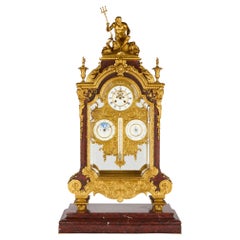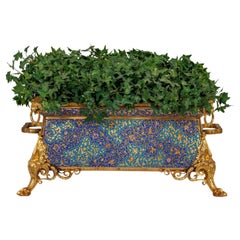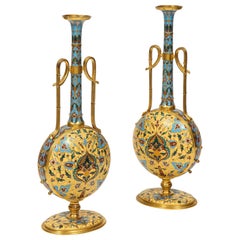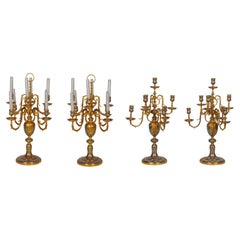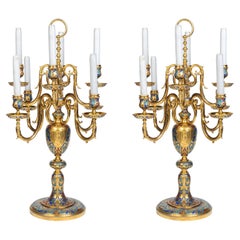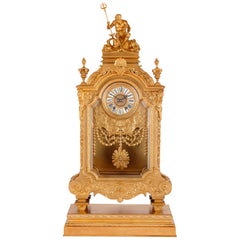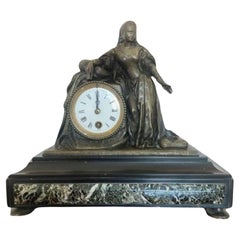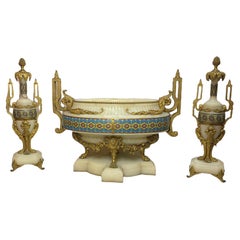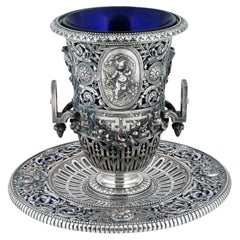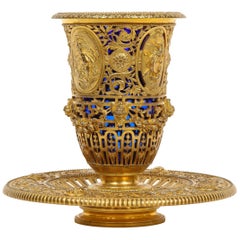Decorative Objects
Best known for his work at the leading bronze foundry Maison Barbedienne in 1855, award-winning French ornamentalist Louis-Constant Sévin created awe-inspiring decorative objects worthy of the most prestigious houses of European royalty.
Born into a creative family in 1821, Sévin studied design and sculpture under Parisian artist Antoine-André Marneuf at the age of 13. In 1839, Sévin left to collaborate with sculptors Phénix and Joyau and design for famous silversmiths François-Désiré Froment-Meurice and Henri Duponchel. He then moved to London in order to evade the 1848 revolution, where he worked with goldsmith Léonard Morel-Ladeuil to design pieces that were showcased at the Great Exhibition of 1851.
Sévin returned to France that year to design models for Jouhanneaud and Dubois — a porcelain factory in the celebrated Limoges region of France — before commencing what became his decades-long position as an ornamental sculptor with Ferdinand Barbedienne.
For 23 years, Sévin created lamps, mirrors, boxes and more at Maison Barbedienne, which was one of the most revered foundries in 19th-century France, where its proprietor used electroplating to create ormolu. Working alongside chaser Désiré Attarge, Sévin designed Napoleon III-era works that greatly appealed to European nobility, and both kings of Belgium and Holland, Her Majesty the Queen of England, Madame de Païva and the Kremlin all awarded him commissions — this included his work for the final resting place of Prince Albert at Frogmore House in Windsor.
Sévin gravitated toward ancient Greek motifs and his work often mimicked the ornate detailing associated with design in China and the Middle East. An extraordinary cabinet that features Moorish-style arches is held in the collection of the Metropolitan Museum of Art, while his decorative clock designs, such as the neo-Renaissance-style model that earned Barbedienne the Grand Prix in 1878, are especially demonstrative of Sévin’s talent for creating objects with rich cultural significance.
On 1stDibs, find a collection of antique Louis-Constant Sévin lighting and decorative objects.
Late 19th Century French Neoclassical Antique Decorative Objects
Griotte Marble, Enamel, Ormolu
19th Century French Napoleon III Antique Decorative Objects
Enamel, Ormolu
19th Century French Napoleon III Antique Decorative Objects
Enamel, Ormolu
19th Century French Napoleon III Antique Decorative Objects
Bronze, Enamel, Ormolu
19th Century French Napoleon III Antique Decorative Objects
Bronze, Enamel, Ormolu
Late 19th Century French Neoclassical Antique Decorative Objects
Ormolu, Bronze
1860s French Napoleon III Antique Decorative Objects
Bronze, Enamel
19th Century French Antique Decorative Objects
Bronze
19th Century French Napoleon III Antique Decorative Objects
Ormolu
Early 19th Century Victorian Antique Decorative Objects
Marble, Bronze
Late 19th Century French Empire Antique Decorative Objects
Onyx, Bronze
Late 19th Century French Louis XV Antique Decorative Objects
Marble, Bronze, Ormolu
1910s Vintage Decorative Objects
Other
1890s French Neoclassical Antique Decorative Objects
Marble
19th Century French Neoclassical Revival Antique Decorative Objects
Bronze
19th Century French Louis XVI Antique Decorative Objects
Bronze, Ormolu
Late 19th Century French Grand Tour Antique Decorative Objects
Bronze
Late 19th Century French Renaissance Revival Antique Decorative Objects
Enamel, Bronze, Ormolu
19th Century French Antique Decorative Objects
Ormolu
19th Century French Belle Époque Antique Decorative Objects
Griotte Marble, Bronze, Ormolu
Early 19th Century Victorian Antique Decorative Objects
Marble, Brass
Late 19th Century French Louis XVI Antique Decorative Objects
Bronze
19th Century French Napoleon III Antique Decorative Objects
Ormolu
Late 19th Century French Louis XVI Antique Decorative Objects
Ormolu, Bronze
1870s French Renaissance Revival Antique Decorative Objects
Bronze
Late 19th Century French Louis XVI Antique Decorative Objects
Ormolu, Bronze
Late 19th Century French Belle Époque Antique Decorative Objects
Bronze, Enamel
